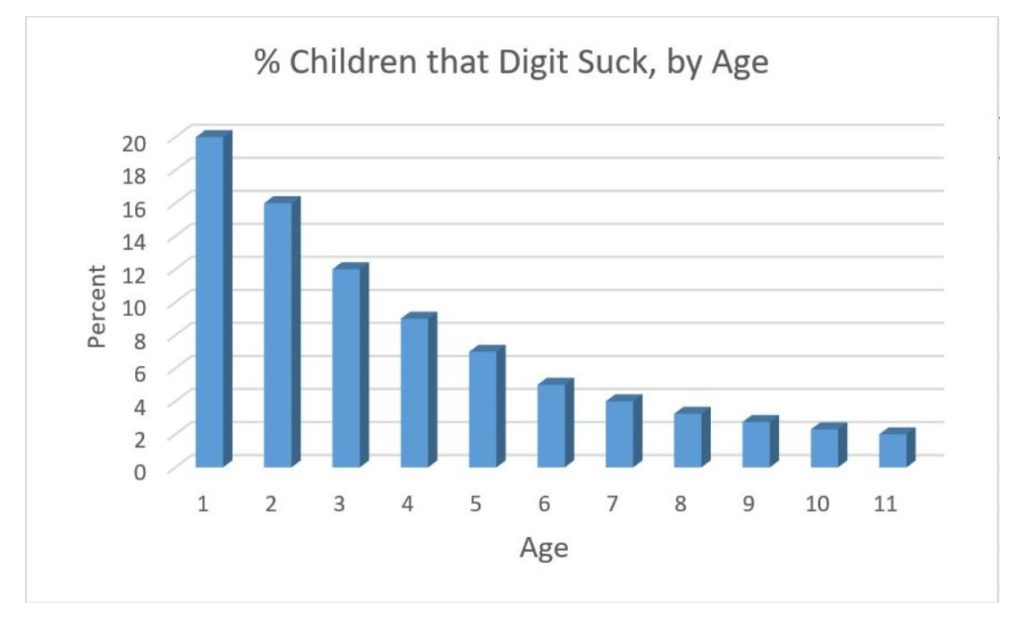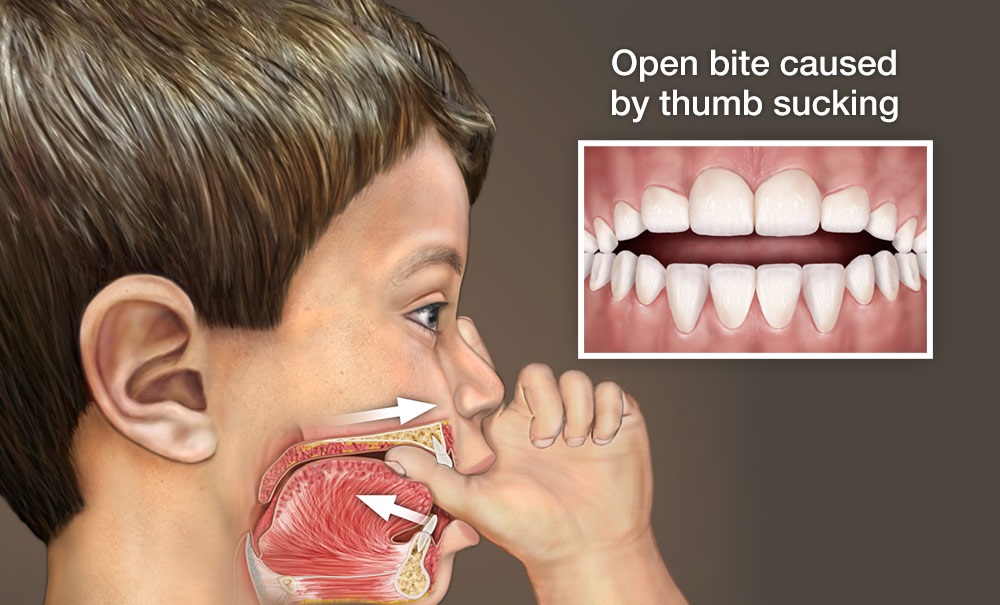
Age Kids Stop Thumb Sucking
Although there are some benefits to thumb sucking for infants and babies, the best time to stop thumb sucking is now. The habit will not stop overnight, so parents should be thinking about how to gain control over the habit rather than let it control their child. It may be surprising to learn that 20% of infants suck on a finger. It is not just common, but also instinctive and natural. By age four more than half have quit. By age six less than 6% of kids still do it – this is the age when the permanent teeth erupt and it is critical to stop digit sucking.

What Age Should Kids Stop Sucking Their Thumb?
What is an inappropriate thumb sucking age? There is a lot of controversy about this among parents. Some parents see the thumb or finger sucking habit as a self-soothing behavior in young children. Some caregivers are not worried about germs and they think it helps the kids develop immunity. Most pediatric dentists recommend children stop around the age of two, while the American Academy of Pediatric Dentists (AAPD) – the most qualified institution – says to intervene at age three. Others testify they sucked their thumb or finger until their teens and never had speech or dental issues. What is the right answer? Should we let kids stop on their own time? When is the right age for the child to stop the digit sucking?
In the womb
Thumbsucking is sometimes seen while still in the womb. According to many studies, this is a sign of a healthy baby to come. It is believed that touching parts of the head and the face is an indicator of how well fetus is developing. And there is nothing you need or can do about it, except to enjoy the pictures from your ultrasound and rest assured the baby appears to be healthy.
Birth to two years of age
This is a time of great expectations and growth.Your little baby is growing so quickly and the body will pass through many visible and even more, invisible changes.
Digit sucking in this period is related to the sucking reflex, associated with for breastfeeding. This sucking reflex usually disappears at about the 4th month of age, but depending on the child could last longer.
Your child is born with 20 buds of primary teeth, they start to appear between the 4th and 6th month of age. This cycle lasts until the 33rd month of age and during this time there can be a lot of discomfort. Teething can be very difficult for some babies while some babies go through all stages of tooth eruption without a problem.
There are a lot of symptoms that are an indication of teething. Underneath the swollen gingiva you can see the tooth finding its way out. Some babies start drooling, chewing and/or sucking on everything they grab. They may have sleeping troubles and their appetite maybe reduced.
Thumb or finger sucking in this stage usually starts as a way of soothing teething symptoms. Fingers are very accessible and are an understandable choice. Up until two years old, if there is visible movement to the palate or teeth, once the habit stops, the damage will correct itself.
Still, as a baby or toddler can be the best age to stop thumb sucking, and start planning how to break a budding habit if the child continues to suck on a finger.
Two to four years of age
Never make your child feel bad about thumb or finger sucking. Try to help them understand why putting the fingers in the mouth is not good for them. Use pictures and props if you have to. Read stories about stopping the habit and maybe tell a personal story how you stopped sucking thumb when you were a child.
Two to four years old is an ideal thumb sucking age to quit, because children at this age want to please and are easier to manage.You can offer small rewards to bribes for success, they are more likely to comply and want to please you at this age. Keeping their little hands busy and offering distractions can jump start the weaning process. Potty training, sleeping in the “big kid” bed, tying shoes, counting, learning letters and sounds, there are so many huge developmental events happening at this age and dropping the digit sucking habit should be on the list too. Kindergarten is not for finger sucking, that time is better spent interacting with other kids. A lot of parents experiment with home remedies at this stage like gloves and hot sauce. There are a lot of devices designed to help. The NIPIT hand stopper, for example, is created to prevent your child from even reaching the mouth easily. This device reduces range motion of the elbow to 100 degrees, and therefore, stops your child from inserting digits into the mouth comfortably. This one is based on the time tested method of wrapping the elbow at night so the finger will drop out of the mouth once the child falls asleep. See the product page for more product reviews.
Four to eight years of age
The longer the habit persists in school aged children, the more fixed the habit becomes and the harder it is to break. Some children stop sucking their thumb at this age because they are worried about what their peers will think. You will find the older the child gets, the harder it is to offer rewards and the harder it is to control the habit. You may choose to invest in a product to help your child with the habit.

If thumb and finger sucking continues after the eruption of permanent teeth (after the age of six) serious changes may occur in your child’s mouth:
1. Interior open bite – When your child sucks the thumb, it pushes upper front teeth forward, and the lower front teeth backward, and the gap will form between the top and bottom row of teeth.
2. Posterior cross bite – Since the thumb pushes the palate up, it narrows the upper arch. Therefore, upper posterior teeth aren’t reaching lower posterior teeth, and the lower set of teeth are now wider than the upper row and the teeth do not fit together nicely.
This is when you may see speech problems, thrusting out the tongue when speaking. The risk of infections is also increased, as the fingers are frequently in the mouth.
While you may succeed in stopping the habit, if the habit stops after the eruption of permanent teeth, you may still need orthodontic intervention. Depending on a nature of oral changes, there are many ways to do it. To stop the habit, your pediatric dentist may recommend a palatal crib or some other appliance. An appliance such as the “rake” costs several hundred dollars. An appliance like this is installed on the roof of the mouth, anchored to the molars and worn for about a year. If you decide to use braces to correct the teeth, they typically cost up to $4500 and most insurance companies will only pay for about half.
Conclusion
The science indicates thumb or finger sucking habit is a comforting and soothing behavior. It is acceptable and has a purpose for a short period of time. If your child has turned this behavior into a true habit, start thinking of ways to motivate you child to stop and about the methods you could use to help your child stop. The best age to stop is two to seven year old, the younger the better, because you have more influence over your kids in this age range; and because there is the least risk for long-term problems. There are several products and lot of good advice in the community to help your child quit thumb sucking. Remember, the best thumb sucking age to stop is now.
